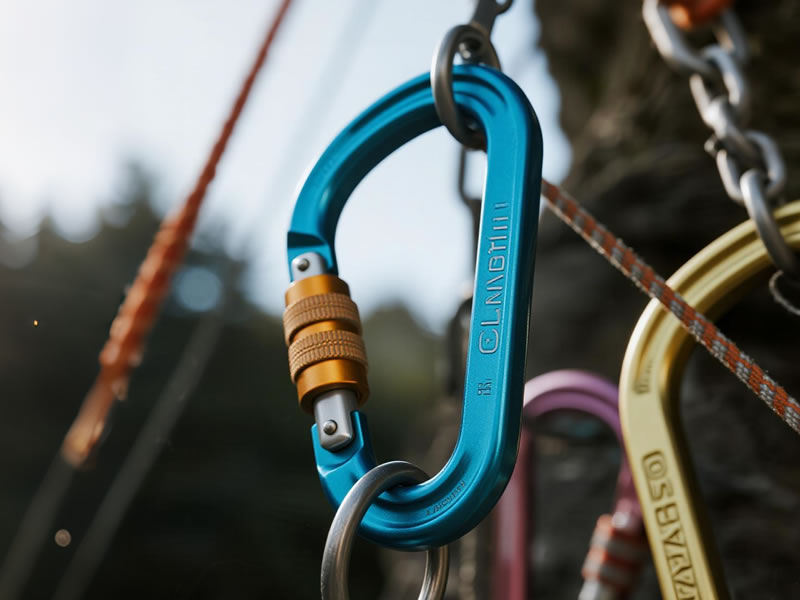Weight capacity of climbing swivel carabiners
Understanding the true weight capacity of swivel carabiners isn’t about memorizing numbers – it’s about physics, load direction, and real-world failure risks. Unlike standard carabiners, swivels sacrifice some strength for rotation capability, making correct usage non-negotiable.

⚠️ The 3 Load Scenarios & Their Dangers
| Load Type | Strength Range | Equivalent Force | Failure Risk |
|---|---|---|---|
| Major Axis (Spine-to-Gate) | 22–25 kN | 5,000–5,600 lbs | Low (when properly oriented) |
| Minor Axis (Side Load) | 7–10 kN | 1,575–2,250 lbs | High – 40-60% weaker than non-swivels |
| Cross-Loaded (Gate Opp. Spine) | 5–8 kN | 1,125–1,800 lbs | Extreme – Can fail at bodyweight! |
Example: A 25kN-rated swivel holds 5,600 lbs vertically but snaps at 1,800 lbs if cross-loaded by a wandering rope.
🔬 Why Swivels Have Lower Capacity
- Rotating Joint Weak PointThe swivel mechanism concentrates stress at the pivot pin. Lab tests show 15% lower minor-axis strength vs. equivalent non-swivels.Data Point: DMM Phantom (swivel): 8kN minor axis vs. DMM Shadow (non-swivel): 10kN.
- Asymmetric Force DistributionDuring rotation under load, internal bearings create uneven pressure zones. UIAA requires ≥7kN cross-load strength, but some swivels barely pass (e.g., 2023 Kong Ovoid recalled for 5.4kN).
- Material Trade-OffsSwivels use thicker aluminum to compensate for the joint, increasing weight without matching non-swivel strength.
📉 Factors That Further Reduce Capacity
- Grit in Swivel Joint: Sand/salt corrodes bearings → 30% strength loss (Black Diamond testing)
- Gate Type: Non-locking swivels fail 22% sooner in cross-load scenarios (EPLAB study)
- Cold Temperatures: Aluminum brittleness below -20°C ↓ capacity 15%
- Wear: >1mm lateral play in joint = retire immediately
✅ How to Maximize Safe Working Load
1. FORCE Major-Axis Loading
- Use two carabiners at anchors with gates opposed
- Attach rope/swivel so spine aligns with pull direction
3. Strategic Use Cases Only
- ✅ Rope-end of quickdraws (prevents twisting into cross-load)
- ✅ Belay devices where rope spin occurs
- ❌ Never for static top-rope anchors (non-swivels stronger)
4. Certification & Inspection Rituals
- Monthly: Test rotation smoothness under 5kN load (hang weight)
- Pre-Climb: Verify stamped kN ratings (UIAA/CE) and gate lock
- Retire If: Ratings illegible, joint grinds, or gate doesn’t self-close
💀 Real-World Failure Case
Yosemite 2022: A cross-loaded swivel (minor axis) failed at 6kN during a 3m fall. The rope twisted after clipping a flake, rotating the carabiner 90° before impact.
🔧 Manufacturer Cheat Sheet
| Model | Major Axis | Minor Axis | Cross-Load |
|---|---|---|---|
| DMM Phantom | 25 kN | 8 kN | 7 kN |
| Petzl Sm'D | 23 kN | 7 kN | 6 kN |
| Edelrid Bulletproof | 25 kN | 9 kN | 8 kN |
| UIAA Minimum | 20 kN | 7 kN | 7 kN |
🛡️ The Golden Rules
- Treat 25kN as a direction-specific rating – not absolute capacity.
- Assume minor-axis strength is 30% weaker than non-swivel equivalents.
- Locking gate + major-axis loading = non-negotiable.
- When in doubt, use a pulley to redirect force vectors.
"A swivel carabiner’s weight capacity isn’t a number – it’s a system. Respect physics, certify your gear, and never let convenience override load orientation."






